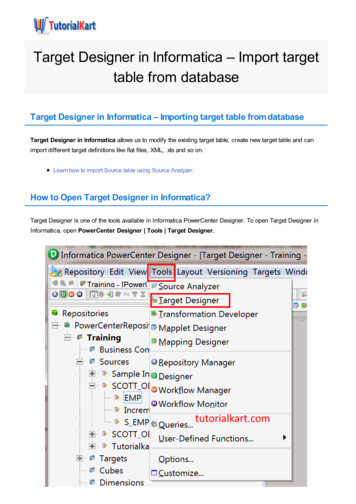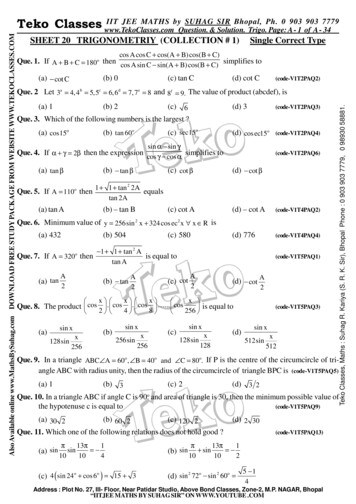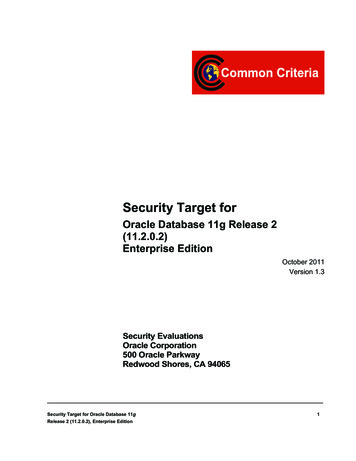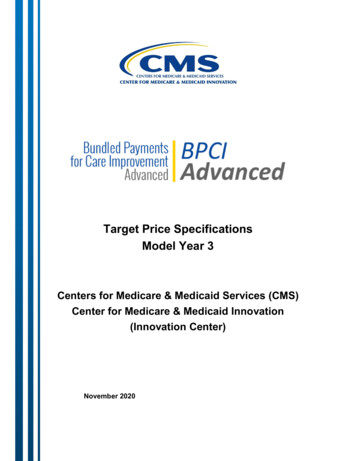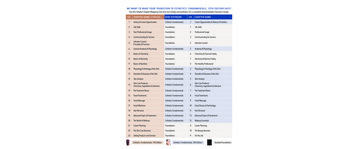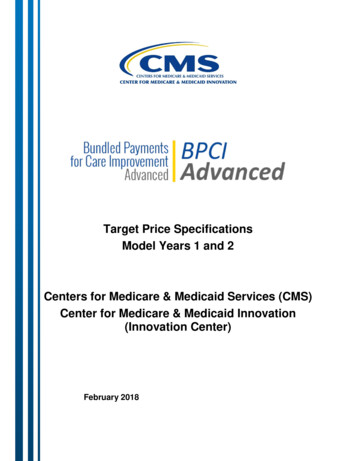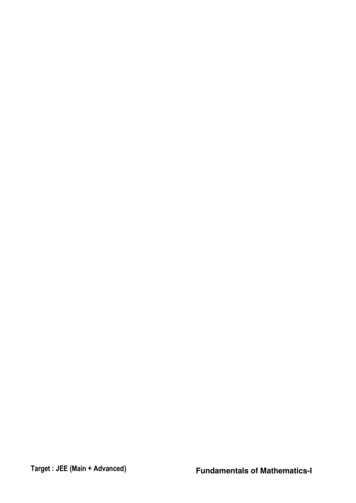
Transcription
Target : JEE (Main Advanced)Fundamentals of Mathematics-I
CONTENT FUNDAMENTALS OF MATHEMATICS - ITopicPage No.Theory01 – 12Exercise # 113 – 20Part - I: Subjective QuestionPart - II: Only one option correct typePart – III: Match the column21 – 26Exercise - 2Part - I: Only one option correct typePart - II: Numerical value questionsPart - III: One or More than one options correct typePart - IV: Comprehension26 – 27Exercise - 3Part - I: JEE(Advanced) / IIT-JEE Problems (Previous Years)Part - II: JEE(Main) / AIEEE Problems (Previous Years)Answer Key:28 – 30Logarithm Table:31 – 32Antilogarithm Table:33 – 34JEE (ADVANCED) SYLLABUSRational inequality, properties of Log, Exponential and Log equations and inequations.JEE (MAIN) SYLLABUSSets : Sets and their representation; Union, intersection and complement of sets and their algebraic properties;Power set; Rational inequality, properties of Log, Exponential and Log equations and inequations. Copyright reserved.All rights reserved. Any photocopying, publishing or reproduction of full or any part of this study material is strictly prohibited. This material belongs to only theenrolled student of RESONANCE. Any sale/resale of this material is punishable under law. Subject to Kota Jurisdiction
Fundamentals of Mathematics-ISETSA set is a collection of well defined objects which are distinct from each other. Sets are generallydenoted bycapital letters A, B, C, . etc. and the elements of the set by small letters a, b, c. etc.If a is an element of a set A, then we write a A and say a belongs to A.If a does not belong to A then we write a A,e.g. the collection of first five prime natural numbers is a set containing the elements 2, 3, 5, 7, 11.METHODS TO WRITE A SET :(i)Roster Method or Tabular Method : In this method a set is described by listing elements,separated by commas and enclose then by curly brackets. Note that while writing the set inroster form, an element is not generally repeated e.g. the set of letters of word SCHOOL maybe written as {S, C, H, O, L}.(ii)Set builder form (Property Method) : In this we write down a property or rule which gives usall the element of the set.A {x : P(x)} where P(x) is the property by which x A and colon ( : ) stands for ‘such that’Example # 1 : Express set A {x : x N and x 2n for n N} in roster formSolution :A {2, 4, 8, 16, .}Example # 2 : Express set B {x3 : x 5, x W} in roster formSolution :B {0, 1, 8, 27, 64}Example # 3 : Express set A {0, 7, 26, 63, 124} in set builder formSolution :A {x : x n3 – 1, n N, 1 n 5}TYPES OF SETSNull set or empty set : A set having no element in it is called an empty set or a null set or void set, it isdenoted by or { }. A set consisting of at least one element is called a non-empty set or a non-void set.Singleton set : A set consisting of a single element is called a singleton set.Finite set : A set which has only finite number of elements is called a finite set.Order of a finite set : The number of distinct elements in a finite set A is called the order of this setand denoted by O(A) or n(A). It is also called cardinal number of the set.e.g. A {a, b, c, d} n(A) 4Infinite set : A set which has an infinite number of elements is called an infinite set.Equal sets : Two sets A and B are said to be equal if every element of A is member of B, and everyelement of B is a member of A. If sets A and B are equal, we write A B and if A and B are not equalthenA B Equivalent sets : Two finite sets A and B are equivalent if their cardinal number is samei.e. n(A) n(B)e.g.A {1, 3, 5, 7}, B {a, b, c, d} n(A) 4 and n(B) 4 A and B are equivalent setsNote - Equal sets are always equivalent but equivalent sets may not be equalReg. & Corp. Office : CG Tower, A-46 & 52, IPIA, Near City Mall, Jhalawar Road, Kota (Raj.)-324005Website: www.resonance.ac.in E-mail : contact@resonance.ac.inToll Free : 1800 258 5555 CIN: U80302RJ2007PLC024029ADVFOMI-1
Fundamentals of Mathematics-IExample # 4 : Identify the type of set :(i)A {x W : 3 x 10}(ii)A { }(iii)A {1, 0, –1, –2, –3,.}(iv)A {1, 8, –2, 6, 5} and B {1, 8, –2, 6, 5}(v)A {x : x is number of students in a class room}Solution :(i)finite set(ii)finite set(iii)infinite set(iv)equal sets(v)singleton setSelf Practice Problem :(1)Write the set of all integers 'x' such that –2 x – 4 5.(2)Write the set {1, 2, 5, 10} in set builder form.(3)If A {x : x2 9, x Z} and B {–2, –1, 1, 2} then find whether sets A and B are equal or not.Answers(1){3, 4, 5, 6, 7, 8}(2){x : x is a natural number and a divisor of 10}(3)Not equal setsSUBSET AND SUPERSET :Let A and B be two sets. If every element of A is an element of B then A is called a subset of B and B iscalled superset of A. We write it as A B.e.g.A {1, 2, 3, 4} and B {1, 2, 3, 4, 5, 6, 7} A BIf A is not a subset of B then we write A BPROPER SUBSET :If A is a subset of B but A B then A is a proper subset of B. Set A is not proper subset of A so this isimproper subset of ANote : (i)(ii)(iii)(iv)(v)(vi)Every set is a subset of itselfEmpty set is a subset of every setA B and B A A BThe total number of subsets of a finite set containing n elements is 2 n.Number of proper subsets of a set having n elements is 2n – 1.Empty set is proper subset of every set except itself.POWER SET :Let A be any set. The set of all subsets of A is called power set of A and is denoted by P(A)Example # 5 : Examine whether the following statements are true or false :(i){a} {b, c, a}(ii){x, p} {x : x is a consonant in the English alphabet}Solution :(iii)(iv)(i)(ii)(iii)(iv){ } { }{a, b} {a, {a}, b, c}False as {a} is subset of {b, c, a}False as x, p are consonantFalse as element , is not in the set { }False as a, b {a, {a}, b, c} and {a, b} {a, {a}, b, c}Example # 6 : Find power set of set A {1, 2, 3}Solution :P(A) { , {1}, {2}, {3}, {1, 2}, {1, 3}, {2, 3}, {1, 2, 3}}Reg. & Corp. Office : CG Tower, A-46 & 52, IPIA, Near City Mall, Jhalawar Road, Kota (Raj.)-324005Website: www.resonance.ac.in E-mail : contact@resonance.ac.inToll Free : 1800 258 5555 CIN: U80302RJ2007PLC024029ADVFOMI-2
Fundamentals of Mathematics-IExample # 7 : If denotes null set then find(a)P( )(c)n(P(P(P( ))))Solution :(a)P( ) { } (c)n(P(P(P( )))) 22 4Self Practice Problem :(4)State true/false :(b)(d)(b)(d)P(P( ))n(P(P(P(P( )))))P(P( )) { ,{ }}n(P(P(P(P( ))))) 24 16A {p, q, r, s}, B {p, q, r, p, t} then A B.(5)State true/false :A {p, q, r, s}, B {s, r, q, p} then A B.(6)State true/false :[4, 15) [–15, 15]Answers(4)False(5)True(6)TrueUNIVERSAL SET :A set consisting of all possible elements which occur in the discussion is called a universal set and isdenoted by U.e.g. if A {1, 2, 3}, B {2, 4, 5, 6}, C {1, 3, 5, 7} then U {1, 2, 3, 4, 5, 6, 7} can be taken as theuniversal set.SOME OPERATION ON SETS :(i)Union of two sets : A B {x : x A or x B}e.g. A {1, 2, 3}, B {2, 3, 4} then A B {1, 2, 3, 4}(ii)Intersection of two sets : A B {x : x A and x B}e.g. A {1, 2, 3}, B {2, 3, 4} then A B {2, 3}(iii)Difference of two sets : A – B {x : x A and x B}. It is also written as A B'.Similarly B – A B A'e.g. A {1, 2, 3}, B {2, 3, 4} ; A – B {1}(iv)Symmetric difference of sets : It is denoted by A B and A B (A – B) (B – A)(v)Complement of a set : A' {x : x A but x U} U – Ae.g. U {1, 2,., 10}, A {1, 2, 3, 4, 5} then A' {6, 7, 8, 9, 10}Disjoint sets : If A B , then A, B are disjoint sets.e.g. If A {1, 2, 3}, B {7, 8, 9} then A B (vi) VENN DIAGRAM :Most of the relationships between sets can be represented by means of diagrams which are known asvenn diagrams. These diagrams consist of a rectangle for universal set and circles in the rectangle forsubsets of universal set. The elements of the sets are written in respective circles.For example If A {1, 2, 3}, B {3, 4, 5}, U {1, 2, 3, 4, 5, 6, 7, 8} then their venn diagram isA BA BA–BA'(A B) (A – B) (B – A)B–ADisjointReg. & Corp. Office : CG Tower, A-46 & 52, IPIA, Near City Mall, Jhalawar Road, Kota (Raj.)-324005Website: www.resonance.ac.in E-mail : contact@resonance.ac.inToll Free : 1800 258 5555 CIN: U80302RJ2007PLC024029ADVFOMI-3
Fundamentals of Mathematics-ILAWS OF ALGEBRA OF SETS (PROPERTIES OF SETS):(i)(ii)(iii)(iv)(v)(vi)(vii)Commutative law : (A B) B A ; A B B AAssociative law : (A B) C A (B C) ; (A B) C A (B C)Distributive law : A (B C) (A B) (A C) ; A (B C) (A B) (A C)De-morgan law : (A B)' A' B' ; (A B)' A' B'Identity law : A U A ; A AComplement law : A A' U, A A' , (A')' AIdempotent law : A A A, A A A(i)(ii)A – (B C) (A – B) (A – C) ; A – (B C) (A – B) (A – C)A , A U UNOTE :Example # 8 : Let A {1, 2, 3, 4, 5, 6} and B {4, 5, 6, 7, 8, 9} then find A BSolution :A B {1, 2, 3, 4, 5, 6, 7, 8, 9}Example # 9 : Let A {1, 2, 3, 4, 5, 6}, B {4, 5, 6, 7, 8, 9}. Find A – B and B – A.Solution :A – B {x : x A and x B} {1, 2, 3}similarly B – A {7, 8, 9}Example # 10 : State true or false :(i)A A A Solution :(i)false because A A' U(ii)(ii)U A Atrue as U A AExample # 11 : Use Venn diagram to prove that A – B A B .Solution :From venn diagram we can conclude that A – B A B .Self Practice Problem :(7)Find A B if A {x : x 2n 1, n 5, n N} and B {x : x 3n – 2, n 4, n N}.(8)Find A – (A – B) if A {5, 9, 13, 17, 21} and B {3, 6, 9, 12, 15, 18, 21, 24}Answers(7){1, 3, 4, 5, 7, 9, 10, 11}(8){9, 21}SOME IMPORTANT RESULTS ON NUMBER OF ELEMENTS IN SETS :If A, B, C are finite sets and U be the finite universal set then(i)n(A B) n(A) n(B) – n(A B) (ii)n(A – B) n(A) – n(A B)(iii)(iv)(v)n(A B C) n(A) n(B) n(C) – n(A B) – n(B C) – n(A C) n(A B C)Number of elements in exactly two of the sets A, B, C n(A B) n(B C) n(C A) – 3n(A B C)Number of elements in exactly one of the sets A, B, C n(A) n(B) n(C) – 2n(A B) – 2n(B C) – 2n(A C) 3n(A B C)Reg. & Corp. Office : CG Tower, A-46 & 52, IPIA, Near City Mall, Jhalawar Road, Kota (Raj.)-324005Website: www.resonance.ac.in E-mail : contact@resonance.ac.inToll Free : 1800 258 5555 CIN: U80302RJ2007PLC024029ADVFOMI-4
Fundamentals of Mathematics-IExample # 12 : In a group of 60 students, 36 read English newspaper, 22 read Hindi newspaper and 12 readneither of the two. How many read both English & Hindi news papers ?Solution :n(U) 60, n(E) 36,n(H) 22n(E H ) 12 n(E H) 12 n(U) – n(E H) 12 n(E H) 48 n(E) n(H) – n(E H) 48 n(E H) 58 – 48 10Example#13 : In a group of 50 persons, 14 drink tea but not coffee and 30 drink tea. Find(i)How many drink tea and coffee both ? (ii)How many drink coffee but not tea ?Solution :T : people drinking teaC : people drinking coffee(i)n(T) n(T – C) n(T C) 30 14 n(T C) n(T C) 16(ii)n(C – T) n(T C) – n(T) 50 – 30 20Self Practice Problem :(9)Let A and B be two finite sets such that n(A – B) 15, n(A B) 90, n(A B) 30. Find n(B)(10)A market research group conducted a survey of 1000 consumers and reported that 720consumers liked product A and 450 consumers liked product B. What is the least number thatmust have liked both products ?Answers(9)75(10)170Intervals :Intervals are basically subsets of R and are commonly used in solving inequalities or in findingdomains. If there are two numbers a, b R such that a b, we can define four types of intervals asfollows :NameRepresentationOpen Interval(a, b)Close Interval[a, b]{x : a x b} i.e. end points are also included. This is possible only whenboth a and b are finite.Open - Closed Interval(a, b]{x : a x b} i.e. a is excluded and b is included.Close - Open Interval[a, b){x : a x b} i.e. a is included and b is excluded.Note : (1)(2)(3)Discription{x : a x b} i.e. end points are not included.The infinite intervals are defined as follows :(i)(a, ) {x : x a}(ii)[a, ) {x : x a}(iii)(– , b) {x : x b}(iv)(– , b] {x : x b}(v)(– ) {x : x R}x {1, 2} denotes some particular values of x, i.e. x 1, 2If there is no value of x, then we say x (null set)General Method to solve Inequalities :(Method of intervals (Wavy curve method) (x – b1 )k1 (x – b2 )k2 (x – bn )kn . (i)Letg(x) (x – a )r1 (x – a )r2 (x – a )rn 12n Where k1, k2 .kn and r1, r2 .rn N and b1, b2.bn and a1, a2 .an are real numbers.Then to solve the inequality following steps are taken.Reg. & Corp. Office : CG Tower, A-46 & 52, IPIA, Near City Mall, Jhalawar Road, Kota (Raj.)-324005Website: www.resonance.ac.in E-mail : contact@resonance.ac.inToll Free : 1800 258 5555 CIN: U80302RJ2007PLC024029ADVFOMI-5
Fundamentals of Mathematics-ISteps : Points where numerator becomes zero are called zeros or roots of the function and where denominatorbecomes zero are called poles of the function.(i)First we find the zeros and poles of the function.(ii)Then we mark all the zeros and poles on the real line and put a vertical bar theredividing the real line in many intervals.(iii)Determine sign of the function in any of the interval and then alternates the signin the neghbouring interval if the poles or zeros dividing the two interval hasappeared odd number of times otherwise retain the sign.(iv)Thus we consider all the intervals. The solution of the g(x) 0 is the union of theintervals in which we have put the plus sign and the solution of g(x) 0 is theunion of all intervals in whichwe have put the minus sign.51 (x – 2)10 (x 1)3 x – (x 8)22 Example# 14 : Solve the inequality if f(x) x 24 (x – 3)3 (x 2)5is 0 or 0.5Solution.1 (x – 2)10 (x 1)3 x – (x 8)212 Let f(x) the poles and zeros are 0, 3,– 2,– 1, ,– 8, 224352x (x – 3) (x 2) 1 If f(x) 0, then x (– , – 8) (– 8, – 2) (– 1, 0) 0, (3, ) 2 1 and if f(x) 0, then x (– 2, – 1) , 2 (2, 3) 2 Ans.Exponential FunctionA function f(x) ax ex In a (a 0, a 1, x R) is called an exponential function. Graph ofexponential function can be as follows :Case - For a 1Case - For 0 a 1Logarithm of A Number :The logarithm of the number N to the base ' a ' is the exponent indicating the power to which the base ' a' must be raised to obtain the number N. This number is designated as loga N. Hence:logaN x ax N , a 0, a 1 & N 0If a 10, then we write log b rather than log10 b.If a e, we write ln b rather than loge b. Here ' e ' is called as Napier's base & has numerical value equalto 2.7182.Rememberlog102 0.3010;log103 0.4771 n 2 0.693; n 10 2.303Reg. & Corp. Office : CG Tower, A-46 & 52, IPIA, Near City Mall, Jhalawar Road, Kota (Raj.)-324005Website: www.resonance.ac.in E-mail : contact@resonance.ac.inToll Free : 1800 258 5555 CIN: U80302RJ2007PLC024029ADVFOMI-6
Fundamentals of Mathematics-IDomain of Definition :The existence and uniqueness of the number loga N can be determined with the help of set ofconditions, a 0 & a 1 & N 0.The base of the logarithm ' a ' must not equal unity otherwise numbers not equal to unity will not have alogarithm and any number will be the logarithm of unity.Graph of Logarithmic function :f(x) logax is called logarithmic function where a 0 and a 1 and x 0. Its graph can be as follows:Case- IFor a 1Case- IIFor 0 a 1Fundamental Logarithmic Identity :aloga N N, a 0, a 1 & N 0The Principal Properties of Logarithm:Let M & N are arbitrary positive numbers, a 0, a 1, b 0, b 1 and are any real numbers,then :(i)loga (M.N) loga M loga N;ingeneralloga(x1x2.xn) logax1 loga x2 . loga xn(ii)loga (M/N) loga M loga N(iii)loga M loga M(iv)(v)1logaM loga M(base changing theorem)logb M loga bloga M NOTE : loga1 0 Note :Example#15: loga a 1log1/a a 1 logba ax ex (i)If the number and the base are on the same side of the unity, then thelogarithm is positive.(ii)If the number and the base are on the opposite sides of unity, then the logarithm isnegative.na Find the value of the followings : 32 9 (i)log272 log2 log2 81 64 (ii)71log25 49 alogc b blogc a 1loga bAns.2Ans.5Reg. & Corp. Office : CG Tower, A-46 & 52, IPIA, Near City Mall, Jhalawar Road, Kota (Raj.)-324005Website: www.resonance.ac.in E-mail : contact@resonance.ac.inToll Free : 1800 258 5555 CIN: U80302RJ2007PLC024029ADVFOMI-7
Fundamentals of Mathematics-ISolution.(i)log272 . 25 32 log2 23.32. 4 . 6 log24 23 2 127 log25 49 7log49 25 7 2(ii)log7 5 5log7 7 5Self practice problem :(11)Find the value of the followings :(i)log49343(ii)4log27243(iii)(iv)log(7 4log(1/100)10003)(7 4 3 )(12)(13)(v)log125625log89.log910 . log6364Find the value of log cot1 log cot2 log cot3 . log cot89 Ans.(11)(i)3/2(ii)(12)2(13)0–1(v)Example#16 : logx(4x – 3) 2Solution.Domain : x 0, 4x – 3 0, x 1Hence 4x – 3 x2 x2 – 4x 3 0x 3 orx 1 (rejected as not in domain)Ans.x 3Exmaple#17 : log2 (log3{log5 (x2 4)} 0Solution.log3(log5(x2 4)} 2 1 log5(x2 4) 31 3 (x2 4) 53 125 Ans.x 1120/3(iii)– 3/2(iv)4/3Logarithmic Equation :The equality loga x loga y is possible if and only if x y i.e.loga x loga y x yAlways check validity of given equation, (x 0, y 0, a 0, a 1) x2 121Example#18 : log2(x2) log2 (x 2) 4Solution.Ans.log2 (x (x 2) 4 x 2x – 16 023x 112x 2 (x – 2) (x 4x 8) 02D 0x 2Self practice problem(14)33log3 x 27(15)(log10x)2 – (log10x) – 6 0(16)3(log7x logx7) 10(17)(x 2)log2 (x 2) 8(x 2)2Ans.(14)(16)x 343, 3 7x 3(15)x 103,1102(17)x 6 or –3/2Logarithmic Inequality : Let 'a' is a real number such that(i)If a 1, then logax loga y(ii)If a 1, then logax (iii)If a 1, then logax (iv)If 0 a 1, then logax logay (v)If 0 a 1, then loga x x y0 x a x a 0 x yx a Reg. & Corp. Office : CG Tower, A-46 & 52, IPIA, Near City Mall, Jhalawar Road, Kota (Raj.)-324005Website: www.resonance.ac.in E-mail : contact@resonance.ac.inToll Free : 1800 258 5555 CIN: U80302RJ2007PLC024029ADVFOMI-8
Fundamentals of Mathematics-I Form - I : f(x) 0, g(x) 0, g(x) 1FormCollection of system(a)logg(x) f(x) 0 ,g(x) 1 f(x) 1 0f(x) 1,0 g(x) 1 (b)logg(x) f(x) 0 , 0 g(x) 1 f(x) 1 g(x) 1 0 f(x) 1 ,(c)logg(x) f(x) a f(x) (g(x))a,g(x) 1 a 0 f(x) (g(x)) , 0 g(x) 1(d)logg(x) f(x) a a g(x) 1 0 f(x) (g(x)) , af(x)(g(x)),0g(x) 1 From - II : When the inequality of the formFormCollection of system(a)log (x) f(x) log (x) g(x) f(x) g(x), (x) 1, 0 f(x) g(x);0 (x) 1(b)log (x) f(x) log (x) g(x) 0 f(x) g(x), (x) 1, f(x) g(x) 0, 0 (x) 1 Example # 19 : Solve the logarithmic inequality log1/5 (2x2 7x 7) 0.Since log1/5 1 0, the given inequality can be written as.Solution.log1/5 (2x2 7x 7) log1/5 1when the domain of the function is taken into account the inequality is equivalent to the system2 2x 7x 7 0of inequalities 2 2x 7x 7 1–3 Solving the inequalities by using method of intervals x –2, 2 Example # 20 : Solve the inequality log1/3 (5x – 1) 0.by using the basic property of logarithm.Solution. 5x – 1 1 5x – 1 0 x 5x 2 5x 1x 2515 1 2 The solution of the inequality is given by , Ans. 5 5 Reg. & Corp. Office : CG Tower, A-46 & 52, IPIA, Near City Mall, Jhalawar Road, Kota (Raj.)-324005Website: www.resonance.ac.in E-mail : contact@resonance.ac.inToll Free : 1800 258 5555 CIN: U80302RJ2007PLC024029ADVFOMI-9
Fundamentals of Mathematics-IExample # 21 :Solution. Solve the inequality log(2x 3) x2 log(2x 3) (2x 3).The given inequality is equivalent to the collection of the systems 0 2x 3 1(i) 2 x 2x 3 (ii) 2x 3 1 0 x 2 2x 3 Solving system (i) we obtain –3 x –1 2 (x – 3)(x 1) 0(iii) System (iii) is equivalent to the collection of two systems –3(iv) 2 x –1, x 3; –3 x –1, x –1(v) 2 –3 , – 1 ,system (iv) has no solution. The solution of system (v) is x 2 solving system (ii) we obtain. x –1 x –1or x (– 1, 3) (x – 3)(x 1) 0 –1 x 3 –3 x ,–1 (– 1, 3) 2 2x Solve the in equation log 2 0.log2x –12x 30 5 Example # 22 : Solution. 10 This in equation is equivalent to the collection of following systems. x 2 – 12x 30x 2 – 12x 30 1, 1, 0 1010and 0 log 2x 1 log 2x 1,2 2 5 5 Solving the first system we have. x 2 – 12x 20 0 (x – 10)(x – 2) 0 x 2 or x 10 2x 2 x 5 x 5 5Therefore the system has solution x 10Solving the second system we have. 0 x 2 – 12x 30 10 x 2 – 12x 30 0 and x 2 – 12x 20 0 5 2x 2 x 5 1 5 2 x 6 – 6 or x 6 6 and 2 x 10 5 x 5 25The system has solutions x 6 – 6 combining both systems, then solution of2the original inequation is.5Ans.x ( , 6 – 6 (10, )2Reg. & Corp. Office : CG Tower, A-46 & 52, IPIA, Near City Mall, Jhalawar Road, Kota (Raj.)-324005Website: www.resonance.ac.in E-mail : contact@resonance.ac.inToll Free : 1800 258 5555 CIN: U80302RJ2007PLC024029ADVFOMI-10
Fundamentals of Mathematics-ISelf practice problems :(18)Solve the following inequalities(i)log3x 5 (9x2 8x 8) 2(ii)log0.2 (x2 – x – 2) log0.2 (– x2 2x 3)(iii)logx (x3 – x2 – 2x) 3Answers :(18) 5 (ii) 2, 2 4 17 (i) – ,– 3 22 (iii) (2, )Characteristic & Mantissa[loga N] is called characteristic of log of N with base ‘a’. It is always an integer.{loga N} is called mantissa of log of N with base ‘a’. Mantissa [0, 1)Characteristic of log of 1 with base 10 0characteristic of log of 10 with base 10 1characteristic of log of 100 with base 10 2characteristic of log of 1000 with base 10 3characteristic of log of 83.5609 with base 10 1characteristic of log of 613.0965 with base 10 2Interval,Cha.(Base 10)[1, 10)[10, 100)[100, 1000)[100, 10000)0123 nnumber of digitsin no1234No. of integers in the interval9 9 10º90 9 101900 9 1029000 9 103(n 1)9 10nNote :If characteristic of a number (base of log is 10) is found to be n, then there would be (n 1) digits in thatnumber.*Characteristic of log of1 0.1 with base 10 – 110Characteristic of log of1 0.01 with base 10 – 2100Characteristic of log of1 0.001 with base 10 – 31000Characteristic of log of3with base 10 – 2100Characteristic of log of3with base 10 – 31000Reg. & Corp. Office : CG Tower, A-46 & 52, IPIA, Near City Mall, Jhalawar Road, Kota (Raj.)-324005Website: www.resonance.ac.in E-mail : contact@resonance.ac.inToll Free : 1800 258 5555 CIN: U80302RJ2007PLC024029ADVFOMI-11
Fundamentals of Mathematics-IIntervalCharacteristic (base 10)No. of zeros immediately after decimalNo.ofinteger resiprocalof which lies in interval.[1/10, 1)–109 9 101–1[1/100, 1/10)–2190 9 102–1[1/103, 1/102) [0.0001, 0.01)–32900 9 103–1[0.0001, 0.001)–439000 9 104–1(n – 1) 9 10n–1 [0.01, 0.1) –nNote :If characteristic of a number (base of log is 10) is found to be –n, then there would be (n –1) zerosimmediately after decimal before first significant digit.Example # 23 Find the total number of digits in the number 1850.(Given log102 0.3010 ; log103 0.4771)Solution.Ans.63N 1850log10N 50 log1018 50 (0.3010 0.9542) 50(1.2552) 62.76Characterstic [log10N] 62No. of digits 62 1 63Self practice problemAns.(19)Find the total number of zeros immediately after the decimal in 6– 200 .(19)155Reg. & Corp. Office : CG Tower, A-46 & 52, IPIA, Near City Mall, Jhalawar Road, Kota (Raj.)-324005Website: www.resonance.ac.in E-mail : contact@resonance.ac.inToll Free : 1800 258 5555 CIN: U80302RJ2007PLC024029ADVFOMI-12
Fundamentals of Mathematics-I Marked questions are recommended for Revision.PART - I : SUBJECTIVE QUESTIONSSection (A) : Representation of sets, Types of sets, subset and power setA-1.State wether the following collections is a set or not ?(i)The collection of natural numbers between 2 and 20(ii)The collection of numbers which satisfy the equation x 2 –5x 6 0(iii)The collection of prime numbers between 1 and 100.(iv)The collection of all intelligent women in Jalandhar.A-2.Write the following set in tabular form(i)A {x : x is a positive prime 10}(ii)B {x : x 3 , x , 1 3}A-3.Write the following set in builder form(i)set of all rational number(ii){2, 5, 10, 17, 26, 37, .}A-4.Identifiy type of set in terms of empty/singleton/finite/infinite(i){x : x is a real number and x2 – 1 0}(ii){x : x is a real number and x2 1 0}(iii){x : x is positive real number and x2 – 9 0}(iv){x : x is a real number and x2 2x 2 0}A-5.Write power set of the set A { , { }}.Section (B) : Operations on sets, Law of Algebra of setsB-1.Given the sets A {1, 2, 3}, B {3, 4}, C {4, 5, 6}, then find the following(i)A (B C)(ii)A – (B C)(iii)(B C) – AB-2.Find the smallest set A such that A {1, 2} {1, 2, 3, 5, 9}B-3.If aN {ax : x N} and bN cN dN, where b, c N, b 2, c 2 are relatively prime, then write 'd' interms of b and c.B-4. Sets A and B have 3 and 6 elements respectively. What can be the minimum and maximum number ofelements in(i)A B(ii)A BSection (C) : Cardinal number ProblemsC-1.Let n(U) 700, n(A) 200, n(B) 300 and n(A B) 100, then find n(A' B')C-2. In a college of 300 students, every student reads 5 newspapers and every newspaper is read by 60students. Find the number of newspaper.C-3. In a town of 10,000 families it was found that 40% families buy newspaper A, 20% families buynewspaper B and 10% families buy newspaper C, 5% families buy A and B, 3 % buy B and C and 4%buy A and C. If 2% families buy all the three news papers, then find number of families which buynewspaper A only.Reg. & Corp. Office : CG Tower, A-46 & 52, IPIA, Near City Mall, Jhalawar Road, Kota (Raj.)-324005Website: www.resonance.ac.in E-mail : contact@resonance.ac.inToll Free : 1800 258 5555 CIN: U80302RJ2007PLC024029ADVFOMI-13
Fundamentals of Mathematics-IC-4. In a survery, it was found that 21 persons liked product A, 26 liked product B and 29 liked product C. If14 persons liked products A and B, 12 liked products C and A, 13 persons liked products B and C and8 liked all the three products then(i) Find the number of persons who liked atleast one product(ii) The number of persons who like the products A and B but not CSection (D) : Rational InequalitiesD-1.Solve the following rational in equalities(i)(x – 1)(x 2) 0(x – 3)(x 3)x2 4 x 4(iii)2x2 x 1D-2. 0 07x 5 48x 314x 9x 30 x 1x 4(ii) (x – 1)(x – 2)(x – 3) 1(x 1)(x 2)(x 3)x2 2(iv)(x 2 – 3x 1)3 0(x 1)(x 2)(iii)x2 5 x 12x2 4 x 5(ii) 3(iv)Solve the following rational in equalities(i)x4 – 5x2 4 0(iii)(x2 3x 1) (x2 3x–3) 5If 1 x2 1 22x2 3 x 459 1x2 1x4 x2 1x2 4 x 5 0x4 – 2x2 – 63 0(ii)x –1 7 then find the range ofx 2(ii) x2(i) xD-6.( x 1)( x2 3 x 4)Solve the following rational in equalities(i)D-5.(2 x2 )( x 3)3(iv)4 3 x x2(iii)D-4.(1– x)3 (x 2)4 0(x 9)2 (x – 8)Solve the following Inequalities(i)D-3. 0( x 2)( x2 2x 1)(v)(ii)(iii)1xFind the number of positive integral value of x satisfying the inequality(3x – 5 x )(x – 2) 0(x 2 5x 2)Section (E) : Logarithmic PropertiesE-1.Find the value of(i)log105.log1020 (log102)21(iii)35 log7 5 1( log10 0.1)1 log7 2(v) 1 49 5– log1/ 5 7log2 9log3 7 8log2 5(ii)5(iv)log0.75 log25log3 5(vi) 710.125log5 7 3log3 7 5log5 3 7Reg. & Corp. Office : CG Tower, A-46 & 52, IPIA, Near City Mall, Jhalawar Road, Kota (Raj.)-324005Website: www.resonance.ac.in E-mail : contact@resonance.ac.inToll Free : 1800 258 5555 CIN: U80302RJ2007PLC024029ADVFOMI-14
Fundamentals of Mathematics-IE-2.Which of the following numbers are positive/negative(i) logE-3.(ii)log1/7(2)(iii)log1/3(1/5)(vi)log3 ( 7 2)(ix) log10 (log10 9)(iv)log3(4)(v)log7(2.11)(vii) 2 1 log4 2 1 (viii) 2· 3 3log3 3 Let log102 a and log103 b then determine the following logarithms in terms of a and b.(iii) log10 sin2 3 log29 log38(i)Let n 75600, then find the value of(ii)If log2 log3 log4 (x) 0 and log3 log4 log2 (y) 0(i)E-4.23(ii)log1004 2 log10027(iv)log 451444321 log2 n log3 n log5 n log7 n and log4 log2 log3 (z) 0 then findthe sum of x, y and z is(iii)Suppose n be an integer greater than 1. let a n 1. Suppose b a2 a3 a4 a5 andlogn 2002c a10 a11 a12 a13 a14. Then find the value of (b – c)E-5.Show that the number log27 is an irrational number.E-6. Ifloga logb logc, show that aa. bb. cc 1. b c c a a bSection (F) : Logarithmic EquationF-1.F-2.Solve the following equations :(i)logx(4x – 3) 2(ii)log2(log3(x2 – 1)) 0(iii)4log2 x 2x 3 0(iv) log4 (log2x) log2 (log4x) 2.(v) 1 log3 log9 x 9x 2x.2 (vi)2log4 (4 – x) 4 – log2 (– 2 – x).(vii) x(viii)x(i)Find the product of roots of the equation(log3x)2 – 2(log3x) – 5 0(ii)Find sum of roots of the equation 4x – 7.2x 6 0(iii)Solve for x : xlog10 x 2 10log10 x 2(iv) Solve for x : x(logx2x) 4log10 x 530.5logx(x2 x) 3log9 4 . 105 log10 xSection (G) : Logarithmic inequalitiesG-1.Solve the following inequalities(i)3 log 5 2x 2 x 18 8 2x 6 02x 1(iii)log7(v)log1/3(2x 2 – 4x) – 2(ii)log 1 ( x2 5 x 6) 12(iv) 2 log1/4(2 – x) log1/4 x 1 Reg. & Corp. Office : CG Tower, A-46 & 52, IPIA, Near City Mall, Jhalawa
Fundamentals of Mathematics-I Reg. & Corp. Office : CG Tower, A-46 & 52, IPIA, Near City Mall, Jhalawar Road, Kota (Raj.)-324005 Website: www.resonance.ac.in E-mail : contact@resonance.ac.in ADVFOMI-1 Toll Free : 1800 258 5555 CIN: U80302RJ2007PLC024029 SETS A set is
